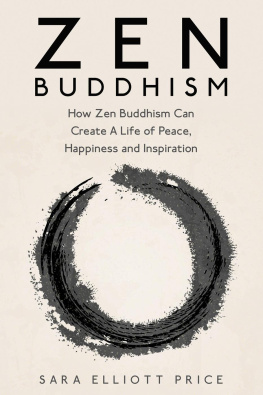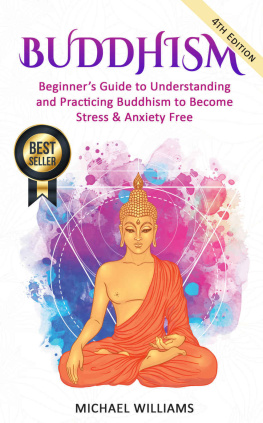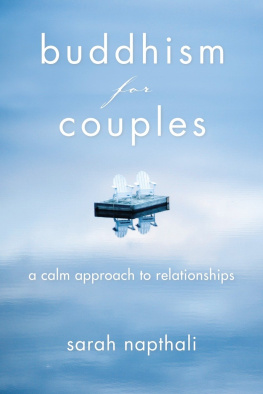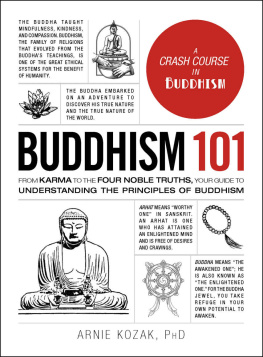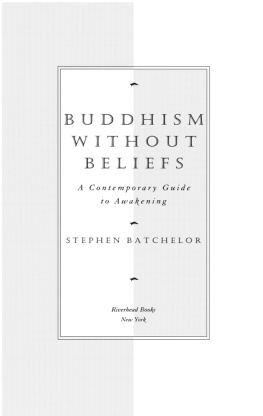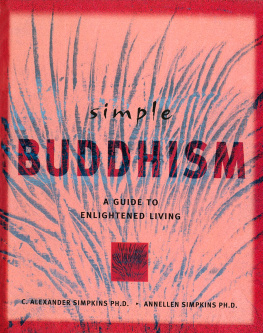Treace - Wake up: how to practice Zen Buddhism
Here you can read online Treace - Wake up: how to practice Zen Buddhism full text of the book (entire story) in english for free. Download pdf and epub, get meaning, cover and reviews about this ebook. City: Emeryville;California, year: 2019, publisher: Rockridge Press, genre: Religion. Description of the work, (preface) as well as reviews are available. Best literature library LitArk.com created for fans of good reading and offers a wide selection of genres:
Romance novel
Science fiction
Adventure
Detective
Science
History
Home and family
Prose
Art
Politics
Computer
Non-fiction
Religion
Business
Children
Humor
Choose a favorite category and find really read worthwhile books. Enjoy immersion in the world of imagination, feel the emotions of the characters or learn something new for yourself, make an fascinating discovery.
- Book:Wake up: how to practice Zen Buddhism
- Author:
- Publisher:Rockridge Press
- Genre:
- Year:2019
- City:Emeryville;California
- Rating:5 / 5
- Favourites:Add to favourites
- Your mark:
- 100
- 1
- 2
- 3
- 4
- 5
Wake up: how to practice Zen Buddhism: summary, description and annotation
We offer to read an annotation, description, summary or preface (depends on what the author of the book "Wake up: how to practice Zen Buddhism" wrote himself). If you haven't found the necessary information about the book — write in the comments, we will try to find it.
Treace: author's other books
Who wrote Wake up: how to practice Zen Buddhism? Find out the surname, the name of the author of the book and a list of all author's works by series.
Wake up: how to practice Zen Buddhism — read online for free the complete book (whole text) full work
Below is the text of the book, divided by pages. System saving the place of the last page read, allows you to conveniently read the book "Wake up: how to practice Zen Buddhism" online for free, without having to search again every time where you left off. Put a bookmark, and you can go to the page where you finished reading at any time.
Font size:
Interval:
Bookmark:

Copyright 2019 by Rockridge Press, Emeryville, California
No part of this publication may be reproduced, stored in a retrieval system, or transmitted in any form or by any means, electronic, mechanical, photocopying, recording, scanning, or otherwise, except as permitted under Sections 107 or 108 of the 1976 United States Copyright Act, without the prior written permission of the Publisher. Requests to the Publisher for permission should be addressed to the Permissions Department, Rockridge Press, 6005 Shellmound Street, Suite 175, Emeryville CA 94608.
Limit of Liability/Disclaimer of Warranty: The Publisher and the author make no representations or warranties with respect to the accuracy or completeness of the contents of this work and specifically disclaim all warranties, including without limitation warranties of fitness for a particular purpose. No warranty may be created or extended by sales or promotional materials. The advice and strategies contained herein may not be suitable for every situation. This work is sold with the understanding that the Publisher is not engaged in rendering medical, legal, or other professional advice or services. If professional assistance is required, the services of a competent professional person should be sought. Neither the Publisher nor the author shall be liable for damages arising herefrom. The fact that an individual, organization, or website is referred to in this work as a citation and/or potential source of further information does not mean that the author or the Publisher endorses the information the individual, organization, or website may provide or recommendations they/it may make. Further, readers should be aware that Internet websites listed in this work may have changed or disappeared between when this work was written and when it is read.
For general information on our other products and services or to obtain technical support, please contact our Customer Care Department within the U.S. at (866) 744-2665, or outside the U.S. at (510) 253-0500.
Rockridge Press publishes its books in a variety of electronic and print formats. Some content that appears in print may not be available in electronic books, and vice versa.
TRADEMARKS: Rockridge Press and the Rockridge Press logo are trademarks or registered trademarks of Callisto Media Inc. and/or its affiliates, in the United States and other countries, and may not be used without written permission. All other trademarks are the property of their respective owners. Rockridge Press is not associated with any product or vendor mentioned in this book.
Interior and Designer: Will Mack
Art Producer: Sue Smith
Editor: Vanessa Ta
Production Editor: Edgar Doolan
ISBN: Print 978-1-64152-390-5 | eBook 978-1-64152-391-2
For Peter Matthiessen, whom I first met when hed forgotten his bessu (Zen priest socks with ankle snaps). He borrowed mine, which were way too small, and flapped about while he processed and bowed conducting a very formal ceremony in front of hundreds.
You were the deepest smile, unflappable even when flapping. May all our Zen be just so.

Contents

TO STUDY ZEN IS TO STOP RUNNING. You sit down with yourself, take a deep breath, take off the mask usually used to hide your pain, and begin to get real. You begin to devote yourself to waking up from what can only be called the trance of habit. Zen practice is a confrontation with the persistent dream that certainty is possible; it is an invitation to relax into a vast unknowing. You begin to see how intoxicating opinions and objects are and commit to a spiritual sobriety informed by spaciousness and silence.
With Zen practice also comes a direct experience of your life as not separate from all other life, which means a tremendous yet tender strength becomes your own. As you stop running from every discomfortyours or othersyour relationship to suffering is transformed. Compassion and kindness become more natural than fear and anger.
In this book, well open up how Zen practice works. Well look a bit at its history, as well as the place it occupies in Buddhism, world religions, and culture more widely. Well look into its traditional shapes and forms but emphasize how to bring it home, to keep it intimately real in this moment. Well do this because, essentially, Zen can only be understood by practicing it. Everything else is description. And though knowing something about Zen may be interesting, until we put our own body and breath into it, it doesnt really begin to address our lives.
I found that true for myself. After years of a kind of noodling around with meditation on my own, I hit a point when I wanted to drench myself in its deepest waters, and I moved to a Zen monastery. Zen has a tradition of cutting through sentimentality, and monasticism implies a single, deep intention shaping a communityboth spoke to me. And I liked that working with a teacher was central to Zen study; I wouldnt be allowed to drift or hide. It was 1983.
Twenty-plus years later, I had lived decades as a monastic, become a priest, and been designated a Zen teacher (Sensei). I completed formal study with my teacher, was named the first dharma successor in my order, and then continued study with several other teachers. I founded a lay Zen center in NYC and oversaw the purchase and renovation of a building (temple) there. After teaching in the city for about ten years, I started a nonresidential training program called Hermitage Heart with students throughout the United States.
All to say, Ive had the great honor (and challenge!) of studying with many wonderful teachers and thousands of students in varied situations for almost 40 years. Ive seen people change the way they live and die, face illness, and experience the incredible stressors of our time. Ive watched as prisoners find the freedom implicit in their mind and patients with debilitating disease find uncommon peace. For all of us, though, it begins with a commitment to wake up. What does that look like?
Most people will find that their enchantment with ego is like a spell that gets broken each time they engage in genuine practice. An alternative begins to wake up in the heart-minda glimpse of something truer, more honest. Breaking from the ego-trance, even momentarily, wakes up a bone-deep calmness: The tension of pretending can be let go, again and again.
If you find yourself drawn to explore Zen practice, you have likely become aware of, or even deeply despaired, the opposite of waking up: the quiet, pervasive sense of being disconnected, stuck in some shade of trance. Its all too easy to waste this unique, precious, and wild life searching in vain for something, anything, to make it better or easier. We run ourselves ragged trying to improve, trying to get to one goal after another, none of which really does the trick. Were always striving and restless, and nothing quite satisfies. No matter how we try to avoid it, the question Who am I? finds us on sleepless nights, or in moments of grief or awe.
Come to these pages as you might to a monastery: with your deepest existential questions alive in your heart, forming the great matter at hand. Be ready to sit down in the center of your life, see clearly, and release the patterns of fear that hold you back. I offer my complete support and faith that you can. Awakening is your birthright.
Next pageFont size:
Interval:
Bookmark:
Similar books «Wake up: how to practice Zen Buddhism»
Look at similar books to Wake up: how to practice Zen Buddhism. We have selected literature similar in name and meaning in the hope of providing readers with more options to find new, interesting, not yet read works.
Discussion, reviews of the book Wake up: how to practice Zen Buddhism and just readers' own opinions. Leave your comments, write what you think about the work, its meaning or the main characters. Specify what exactly you liked and what you didn't like, and why you think so.


